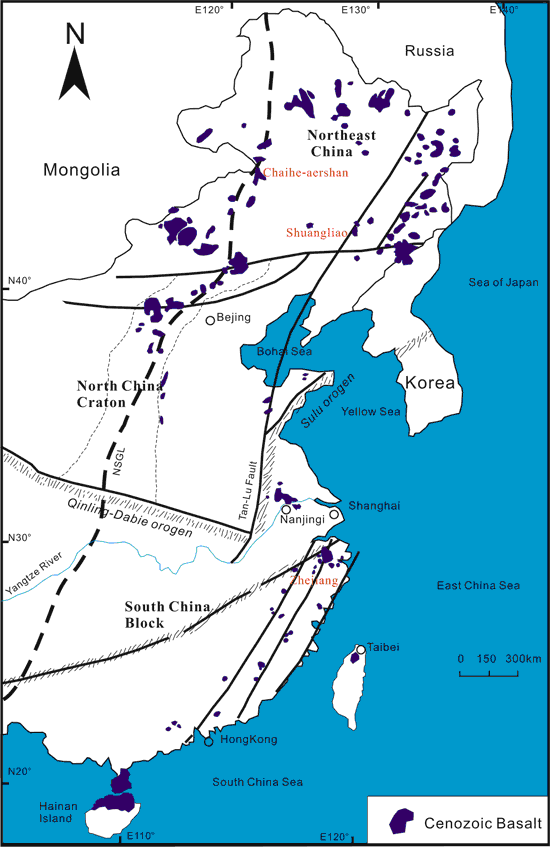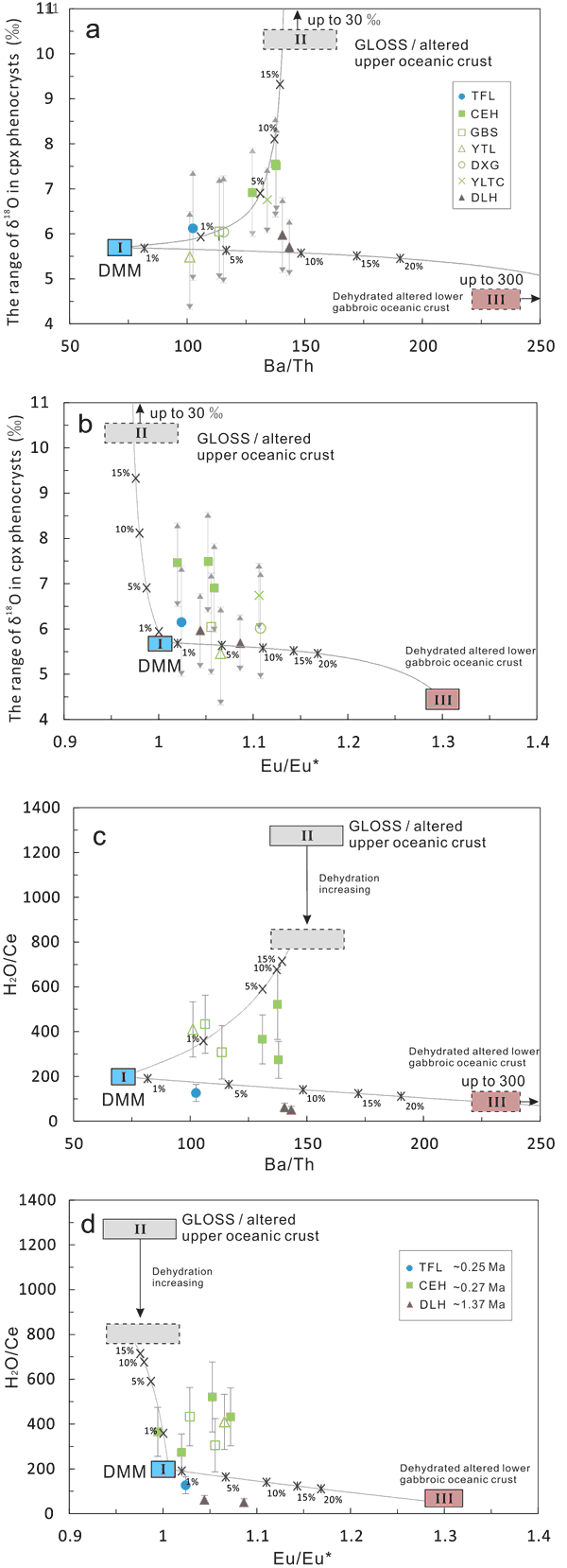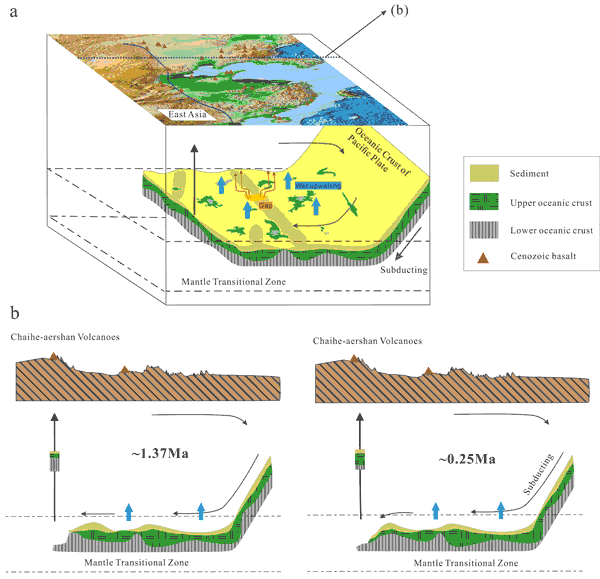 |
Heterogeneous source components of intraplate basalts from eastern China from ongoing Pacific slab subduction |
Huan Chen1,2, Qun-Ke Xia3, Jannick Ingrin2, Etienne Deloule4, Yao Bi1
1CAS Key Laboratory of Crust-Mantle Materials and Environments, School of Earth and Space Science, University of Science and Technology of China, Hefei, 230026 China; rainbow1@mail.ustc.edu.cn; biyao@mail.ustc.edu.cn
2UMET, UMR CNRS 8207, Université de Lille1, Bât. C6, 59655 Villeneuve d’Ascq, France; jannick.ingrin@univ-lille1.fr
3School of Earth Sciences, Zhejiang University, Hangzhou, 310027 China; qkxia@zju.edu.cn
4CRPG, UMR 7358, CNRS Université de Lorraine, 15 rue Notre-Dame-des Pauvres, 54501 Vandoeuvre-les Nancy, France; deloule@crpg.cnrs-nancy.fr
This webpage is a summary of Chen, Huan, Qun-Ke Xia, Jannick Ingrin & Etienne Deloule, Heterogeneous source components of intraplate basalts from NE China induced by the ongoing Pacific slab subduction, Earth Planet Sci Lett, 2017, 459: 208-220, doi: 10.1016/j.epsl.2016.11.030.
Introduction
The genesis of small-volume continental intraplate basalts has been hotly debated and no clear mantle plume structure has been detected using seismic tomography beneath most basaltic volcanoes. Cenozoic continental basalts are widespread in eastern China and provide an opportunity to study such magmatism. Seismic imaging has identified the remnants of the subducted Pacific slab in the mantle transition zone (MTZ) of eastern China (Huang & Zhao, 2006). Recently, novel geochemical approaches have been developed to trace different components that are involved in the mantle source, such as the H2O content of magma, O isotopic compositions of phenocrysts, Mg isotopic compositions of bulk rocks, and the compositions of melt inclusions (e.g., Huang et al., 2015; Li et al., 2016; Liu et al., 2015; Wang et al., 2015). Traces of recycled oceanic crust have been recognized in the mantle source of these basalts, and have been linked to the stagnant Pacific slab in the MTZ. However, recycled oceanic materials could also result from ancient subduction events (e.g., Paleo-Tethyan, Paleo-Asian or Izanagi plate subduction). The subduction event that introduced recycled materials into the mantle source of the Cenozoic basalts of eastern China and Asia is thus ambiguous..
Recycled oceanic slab is a mixture of sediments, upper oceanic crust and lower gabbroic oceanic crust. Slabs undergo various degrees of alteration and dehydration during the recycling process (e.g., Pietruszka et al., 2013). Understanding the temporal and spatial variations of the source components of the widespread intraplate small-volume basalts in eastern China will contribute to assessing the effect of the slab on mantle heterogeneity and the relationships between the slab and the basalts. This may help to understand the influence of the subducted Pacific slab.
Results and discussion
The Chaihe-aershan volcanic field (Figure 1) is located above the front edge of the subducted Pacific slab and includes more than 35 small-volume Quaternary basaltic volcanoes younger than 2 Ma (Huang & Zhao, 2006; Zhao & Fan, 2012). This provides an opportunity to study the evolution of mantle sources in detail and trace the possible effects of the Pacific slab. In addition to major- and trace-element concentrations of whole rocks for the Chaihe-aershan basalts, we measured the oxygen isotopic compositions and water contents of clinopyroxene (cpx) phenocrysts using secondary ion mass spectrometry (SIMS) and Fourier transform infrared spectroscopy (FTIR), respectively. The water contents (H2O wt.%) of the magmas were calculated using the water contents of the cpx phenocrysts and the partition coefficients of H2O between cpx and basaltic melt.

Figure 1: The locations of Cenozoic basalts in eastern China.
The large variations in the H2O contents of the Chaihe-aershan “primary” magmas (0.23-2.70 wt.%) and the δ18O values of the cpx phenocrysts (4.27-8.57‰) demonstrate compositional heterogeneity in the mantle source. The δ18O value and H2O content within individual samples also vary considerably (1.28-2.31‰ for δ18O), suggesting the mixing of magmas shortly before the eruption.
Based on the relations among the δ18O values of the cpx phenocrysts, the H2O/Ce and Ba/Th ratios and the Eu anomaly of bulk rocks, three components (hydrothermally altered upper oceanic crust and marine sediments, altered lower gabbroic oceanic crust, and ambient mantle) can be identified in the mantle source (Figure 2).

Figure 2: Comparison of the range of δ18O values in cpx phenocrysts and the trace-element ratios (H2O/Ce, Ba/Th and Eu/Eu*) in the Chaihe-aershan basalts.
The relative contributions of recycled oceanic components in the mantle source changed significantly over a short time (Figure 2). For example, in the mantle source of earlier basalts (e.g. from Delehe, a volcano in the Chaihe-Aershan volcanic field, 1.37 Ma), recycled altered lower gabbroic oceanic crust and ambient normal mantle dominate (with a positive Eu anomaly and relatively low δ18O and H2O/Ce). After an interval of 0.25-0.27 Ma, marine sediments and altered upper oceanic crust became the major enriched components in the source, forming water-rich basalts in Chaerhe volcano (with high δ18O values and H2O/Ce ratios). The Cenozoic basalts of the Shuangliao volcanoes in NE China (Figure 1) show similar features: the upper oceanic crustal component and ambient normal mantle melted earlier (~51 Ma) whereas recycled marine sediments were involved in the mantle source later (~43 Ma) (Chen et al., 2015; Xu et al., 2012). In addition, Liu et al. (2016) studied the Zhejiang basalts (26-17 Ma to < 11 Ma) in SE China (Figure 1) and also identified an additional recycled dehydrated sediment component in the source of the younger basalts.
The Pacific slab has subducted beneath eastern Asia since at least 80 Ma (Maruyama et al., 1997), a process that continuously transports recycled materials into the mantle. The proportion of recycled components in the mantle is affected by this ongoing subduction which may thus provide a reasonable explanation for the variations in recycled components in the mantle source of eastern China basalts over time.

Figure 3: Heterogeneity and evolution of mantle sources of Cenozoic intraplate basalts in eastern China. Click here or on Figure for enlargement.
Cenozoic basalts in different parts of eastern China contain variable contributions of recycled components (Chen et al., 2015, 2017; Liu J et al., 2015a,b; Liu et al., 2016). The proportion and composition of recycled components in different mantle sources are expected to vary as a result of different degrees of alteration and dehydration during the recycling process. This could account for the heterogeneous mantle source of the intraplate basalts in eastern China (Figure 3a). In Figure 3b, recycled components in the mantle sources of Delehe basalts are dominated by recycled altered lower gabbroic oceanic crust components. As subduction progressed the contributions of marine sediments and altered upper oceanic crust increased.
Conclusions
The source components of Cenozoic intraplate small-volume basalts in eastern China are temporally and spatially heterogeneous. This can be explained by ongoing subduction of the Pacific slab. Identifying the subducted oceanic plate that provides enriched components in the mantle source can be done by matching temporal variations in geochemistry with the tectonic history of the study area.
Acknowledgements
Financial support was provided by the National Science Foundation of China (No. 41225005).
References
-
Chen, H., Xia, Q. K., Ingrin, J., Jia, Z. B. & Feng, M. Changing recycled oceanic components in the mantle source of the Shuangliao Cenozoic basalts, NE China: new constraints from water content. Tectonophysics 650: 113-123 (2015).
-
Chen, H., Xia, Q. K., Ingrin, J., Deloule, E. & Bi, Y. 2017 Heterogeneous source components of intraplate basalts from NE China induced by the ongoing Pacific slab subduction. Earth Planet. Sci. Lett. 459: 208-220 (2017).
-
Huang, J., Li, S. G., Xiao, Y., Ke, S., Li, W.Y. & Tian, Y. Origin of low δ26Mg Cenozoic basalts from South China Block and their geodynamic implications. Geochim. Cosmochim. Acta 164: 298-317 (2015).
-
Huang, J. & Zhao, D. High-resolution mantle tomography of China and surrounding regions. J. Geophys. Res. doi: 10.1029/2005JB004066 (2006).
-
Li, H. Y., Xu, Y. G., Ryan, J. G., Huang, X. L., Ren, Z. Y., Guo, H. & Ning, Z.G. Olivine and melt inclusion chemical constraints on the source of intracontinental basalts from the eastern North China Craton: Discrimination of contributions from the subducted Pacific slab. Geochim. Cosmochim. Acta 178: 1-19 (2016).
-
Liu, J., Xia, Q. K., Deloule, E., Chen, H. & Feng, M. Recycled oceanic crust and marine sediment in the source of alkali basalts in Shandong, eastern China: evidence from magma water content and oxygen isotopes. J. Geophys. Res. 120: 8281-8303 (2015a).
-
Liu, J., Xia, Q. K., Deloule, E., Ingrin, J., Chen, H. & Feng, M. Water content and oxygen isotopic composition of alkali basalts from the Taihang Mountains, China: Recycled oceanic components in the mantle source. J. Petrol. 56: 681-702 (2015b).
-
Liu, S. C., Xia, Q. K, Choi, S. H., Deloule, E., Li, P. & Liu, J. Continuous supply of recycled Pacific oceanic materials in the source of Cenozoic basalts in SE China: the Zhejiang case. Contrib. Mineral. Petrol. 171(12): 1-31 (2016).
-
Maruyama, S., Isozaki, Y., Kiruma, G. & Terabayashi M. Paleogeographic maps of the Japanese Islands: Plate tectonic synthesis from 750 Ma to the present. Isl. Arc 6: 121-142 (1997).
-
Pietruszka, A. J., Norman, M. D., Garcia, M. O., Marske, J. P. & Burns, D.H. Chemical heterogeneity in the Hawaiian mantle plume from the alteration and dehydration of recycled oceanic crust. Earth Planet. Sci. Lett. 361: 298-309 (2013).
-
Wang, X. C., Wilde, S. A., Li, Q. L. & Yang, Y. N. Continental flood basalts derived from the hydrous mantle transition zone. Nat. Commun. doi:10.1038/ncomms8700 (2015).
-
Xu, Y. G., Zhang, H. H., Qiu, H. N., Ge, W.C. & Wu, F. Y. Oceanic crust components in continental basalts from Shuangliao, Northeast China: Derived from the mantle transition zone? Chem. Geol. 328: 168-184 (2012).
-
Zhao, Y. W. & Fan, Q. C. Mantle Sources and magma genesis of Quaternary volcanic rocks in the Halaha River and Chaoer River area, Great Xing’an Range. Acta Petrol. Sin. 28: 1119-1129 (2012).
last updated 12th February, 2017 |
